#medieval meal
Explore tagged Tumblr posts
Text
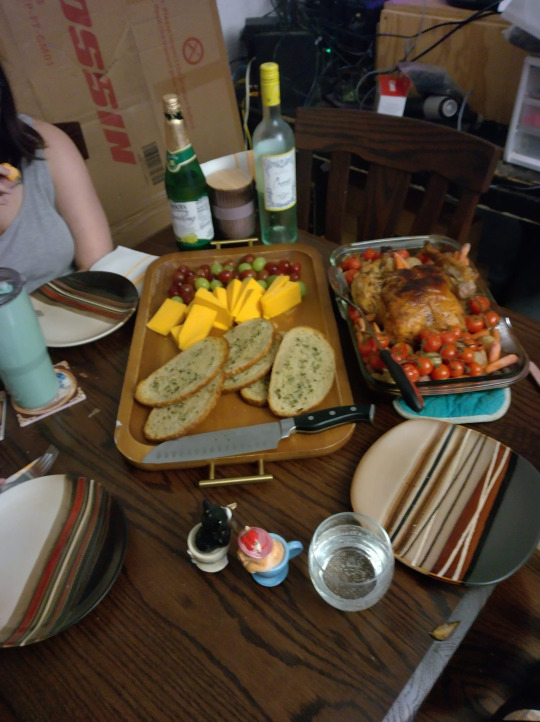
I made a medieval fantasy style meal for dinner tonight! It was super easy to do and it was fun kind of like going to medieval times when I was 10! I had some Welch's sparkling grape juice with it (since I can't drink alcohol because of my antipsychotics), and mom and sibling had wine! And I made the bread into garlic bread on a last minute whim, but my god bitch, I got it to the PERFECT kind of crunchy. Sometimes you just have to eat like a medieval peasant splurging at a tavern and that's FUN. Gotta eat like you are chilling in a Neverwinter Tavern and the adventuring life is good.
#food#medieval meal#medieval#tavern meal#tavern#chicken#roast vegetables#garlic bread#sliced cheese#grapes#dinner#my photos#From Eater's Realm#ttrpg inspired#ttrpg meal#ttrpg#dnd meal
6 notes
·
View notes
Text
me, eating a pile of nuts, cheese, and apple: mmmm tasty
the medieval peasant in my head watching me eat: thou knowst what would MAKETH this meal? dried fruits.
me, getting out the raisins: god damn, etheldred, you are SO right
the medieval peasant in my head: yet thou art still not heeding mine words regarding the blasphemy

#i never feel closer to medieval peasants than when i eat a meal of apple and cheese#(<- revised gluten free version (used to be cheese and bread))#the nuts are a recent addition but still very medieval feeling#and dried fruits???? oh babey now that's not just an after dinner snack that's a whole entire meal
88K notes
·
View notes
Text
I'm throwing a time travel party today (mostly as a birthday thing, although the fact that it's also an important BttF date is a bonus) where the idea is we all dress up in historical outfits and bring foods from completely different eras, but that also means that I am currently in the middle of making both 1) Hildegard von Bingen's cookie recipe and 2) a 1950s Jello abomination
Which is, I think, the funniest combination possible
#i will post pictures and recipes later but!! i have a fun spread planned#including a recipe inspired by one of the last meals served on the titanic and also a medieval saffron rice that sounds amazing
79 notes
·
View notes
Text
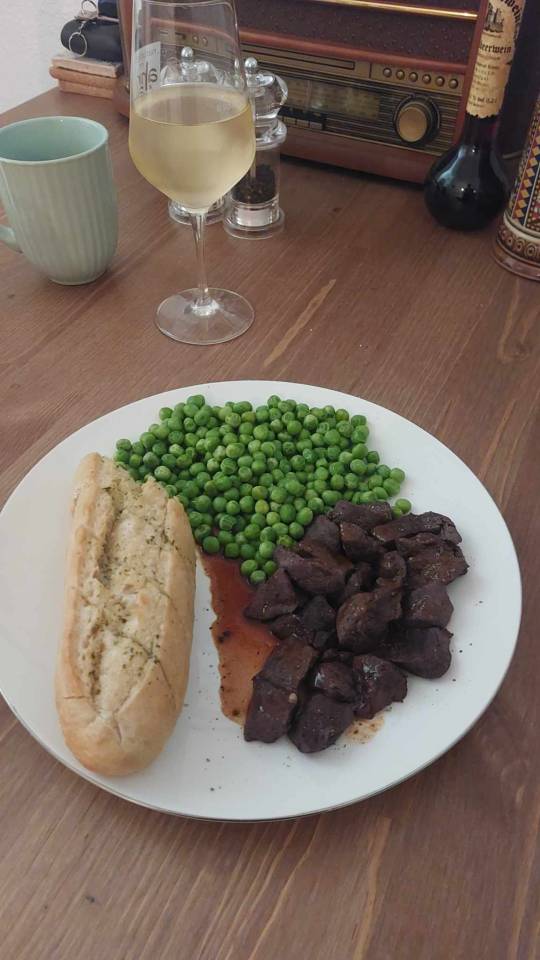

TEMPLAR BOAR WITH CAMELINE SAUCE (14th c.)
This past Thursday, the Corpus Christi public holiday in my part of Germany, known here as Fronleichnam, gave me a little extra time to make another Tasting History dish: Templar Boar with Cameline Sauce. The diet, eating habits, and table manners of the Templars were governed by strict rules, including only eating meat three times a week (two meat meals on Sundays). This dish was one of those they would have eaten for one of their meat meals during the 14th century. The spices present in the sauce would have been accessible to them during the crusades, but Cameline Sauce did become a popular dish in much of medieval Europe eventually. This dish is based on two 14th century primary sources: Le Viandier de Taillevent by Guillaume Tirel and Le Ménagier de Paris, a treatise written by an older man (as yet unnamed) to teach his 15-year-old bride how to run his household and please him, in every way (...yikes). The sauce, Cameline, is named as such due to the rich brown colour, which looks like the wool of a camel, also known as cameline. I chose to make this recipe next because I haven't made boar before, and the rich, silky, brown colour of the sauce made it look really tasty. See Max’s video on how to make it here or see the ingredients and process at the end of this post, sourced from his website.
My experience making it:
I made a couple changes to the modern recipe below. I used boar goulash pieces instead of tenderloin, because it was the only form of boar I could find at my grocery store. The white wine I used (and drank with dinner) was a dry Riesling from the Mosel Valley in Germany. The red wine was a Bordeaux Merlot. I used saffron powder instead of threads, and I did opt to add the optional tablespoon of red wine vinegar. the white bread I used was a classic French baguette.
I also made a couple changes to the method. Because I used French baguette, which has quite small slices, I hollowed out about half the baguette (since baguettes are mostly crust). I also simmered the sauce for much longer than Max says to, because it wasn't quite the thickness I was looking for. Otherwise, I followed Max's recipe exactly, probably to the detriment of my boar. Because I had used goulash pieces instead of tenderloin, I probably should have adjusted how I cooked the boar to accommodate these smaller pieces. Unfortunately, I didn't, and as a result, I was left with very chewy, dry boar. Basically, the sauce was the saving grace of the boar! I served the boar and Cameline sauce with some green peas, garlic bread, and a glass of the dry Riesling wine.
My experience tasting it:
I already knew I had ruined the texture of the boar, but I hoped that the sauce would help. I warned my husband. Luckily, the Cameline sauce did a lot of heavy-lifting to bring some moisture back to the board. The sauce turned out wonderfully - a beautiful, silky brown. Flavour-wise, it reminded me of a jus, but more heavily-spiced. I was worried the Cameline sauce would end up tasting sweet due to the brown sugar and several spices that are more often used in baking, but in fact, the spices were well balanced by the taste of the wine and vinegar. The sauce also went really nicely with the peas, and I imagine would also have tasted good with potatoes or other red meats. My husband and I dipped the garlic bread in it as well, which was really tasty. It went alright with the dry boar, but I would like to use the sauce with another, more tenderly-cooked meat. We had leftover Cameline sauce, so we will probably try that again tonight. If you end up making it, if you liked it, or if you changed anything from the original recipe, do let me know!
Links to harder-to-find ingredients:
Saffron
Templar Boar with Cameline Sauce original recipes (14th c.)
Sourced from Le Viandier de Taillevent by Guillaume Tirel and Le Ménagier de Paris respectively.
“Sanglier: Fresh Wild Boar Venison. Cooked in wine and water and boiled again; eaten with Cameline Sauce.”
— Le Viandier de Taillevent, 14th century
“Cameline. Note that in Tournai, to make cameline they grind ginger, cinnamon, saffron, and half a nutmeg, moistened with wine then taken out of the mortar. Then grind in a mortar untoasted white breadcrumbs that have been soaked in cold water, moisten with wine and strain. Then boil everything and finish with brown sugar, and that makes winter cameline. In the summer, they do the same but it is not boiled at all. ”
— Le Ménagier de Paris, 14th century
Modern Recipe
Based on Le Viandier de Taillevent by Guillaume Tirel, Le Ménagier de Paris, and Max Miller’s version in his Tasting History video.
Ingredients:
Boar tenderloin
Olive oil for searing
Equal parts wine and water for boiling
1 thick slice of white artisanal bread without crust
1 ¼ cups white wine
¼ cup red wine
1 tsp ginger
2 tsp cinnamon
½ tsp nutmeg
Pinch of saffron threads
2 tbsp brown sugar
Pinch of salt
1 tbsp red wine vinegar (optional)
Method:
De-crust the bread and break it into small pieces. Soak the bread in water for a few hours, then pour in the red wine for the sauce.
Heat olive oil in a pot then sear the boar on all sides.
Remove it from the pot and boil equal parts wine and water, then add the boar back in and boil, covered, for 10-15 minutes or until fully cooked. Then let it rest.
To make the sauce, mix the spices and white wine. Strain the bread/wine mixture from earlier into a saucepan, then press the bread through the strainer.
Add the spiced wine mixture and bring to a simmer. Let simmer for 15 minutes, or until half reduced, then add the sugar and salt, and if you want, a tablespoon of red wine vinegar. Simmer until thickened.
Slice the boar and pour the sauce over it. Optionally, serve with roasted chestnuts and wine.
#14th century#max miller#tasting history#cooking#tasting history with max miller#keepers#medieval meals#boar#french recipes#europe#Templar#crusades#Cameline Sauce#Sauces#meat#Le Viandier de Taillevent#Le Menagier de Paris#Guillaume Tirel#Europe#France
83 notes
·
View notes
Text
having historical reenactment hobbies is awesome bc you can feel a connection between yourself and people who lived centuries ago. in deeply hilarious ways
#[me doing something stupid as fuck] wow i bet a little Italian boy in the 1500s also did this#okay yes its also profoundly beautiful to be doing thousand year old dance steps. chatting with ppl in the kitchen while preparing#medieval english meals. fucking blanching almonds or wtv#more importantly tho its fucking hilarious#my shit#sca#probably should start a tag fkr that here. unfortunately im committed now yall
11 notes
·
View notes
Text
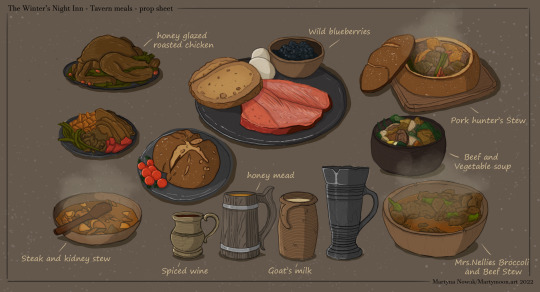
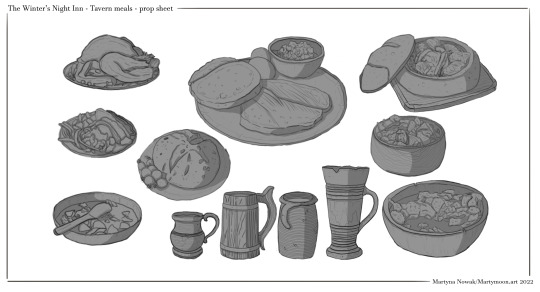
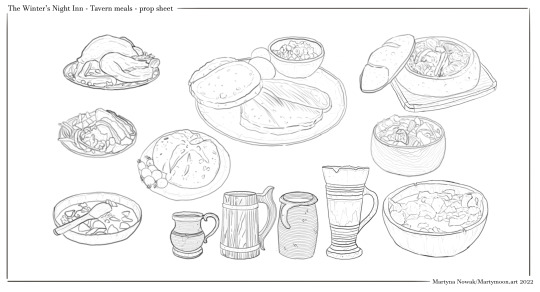
Medieval tavern meals. Prop design sheet for personal project - The Winter's Night Inn. Hope these make ya'll hungry!
#Digital 2D#Animation#Mixed Media#Concept Art#Props#Visual Development#food#medieval#meal#illustration#cartoon#animation#game#art#2d#digital#dnd#fantasy#fantasy art#artists on tumblr
7 notes
·
View notes
Text







My Arisen, Nimh 🍠
#nimh#dragon's dogma 2#dd2#rest in peace to lir in the last image i used his K.O. rift fog as a background....#some shots of my arisen for once.... hehe#why sweet potato emoji?? who knows.... medieval meal#.txt
22 notes
·
View notes
Text
today we're making bread AND carrot cake
they'll bake separately, but if I need to have my oven on, I might as well take full advantage of it, you know?
#jau rants#bread was a request from partner for dinner#medieval peasants had it right so bread and cheese is a regular meal choice now
15 notes
·
View notes
Text

Mia The Mage
(Art Fight Character)
#Here is Mia she is a mage who flunked from the prestigious Magic School#Shunned from the greater magic society she struggles to even find a meal to eat#Her overly cutesy persona hides her abandonment issues and her low self esteem#or something rant#or something art#fantasy oc#medieval fantasy oc#Oc#original character#artist of tumblr#Magical girl oc#Art fight#art fight 2025
3 notes
·
View notes
Text
if you guys want a little peek into my writing process for ties that bind im currently writing an incredibly small line that ive decided has to be totally accurate so

#last chapter i researched what an average meal would be in medieval times and then just made whatever the general got a little bit worse#froggie speaks
5 notes
·
View notes
Text
Dungeon meshi has wonderful and thought out world building but the inherent creator bias still shows through sometimes in small funny ways
#dungeon meshi#ep 1#why are they eating with chopsticks when the island is mostly western in architecture/culture etc#hahaha#i always think its so funny even in like medieval isekais/webtoons#when everyone has european names#castles#dresses etc#but their school system is japanese or their meals etc#like the small stuff the author thinks is normal#calling the duke 'hyung' when there is absolutely no way that would happened at that time#its a bit endearing#i read a brothers grimm/fairy tale inspired manga#and the protag is a grimm brother who befriends hans christian andersen and subsequently calls him “an-chan”#western media has that a lot too#people eating with forks when they would use chopsticks#having meals with beef in them when its a terrain where cows wouldnt live and chicken or goat or fish would make more sense#eastern media aallllwaaysss including an age based honorifics system#western media often modeling religion along the abrahamic faiths#etc
29 notes
·
View notes
Text
I ate 1 bag of candy over the course of two days, and ~1/3rd of a bag of potato chips in one sesh last night, and I will never do that again anymore in my entire life 🥲
#Reflux disease loves it too#It were fine Belgian sour powder candy balls and paprika-flavoured crisps and my entire system today goes: ❗️📛❌️🚮📛❗️#I usually live off apples and oatmeal and knackebröd and fish like a medieval German horse#And I cook 9 out of 10 meals myself#So these officially aren't my types of food any longer. I pay the price... 🥲
5 notes
·
View notes
Text
eating a ton of cheese and crackers for dinner (life is beautiful sometimes)
3 notes
·
View notes
Text
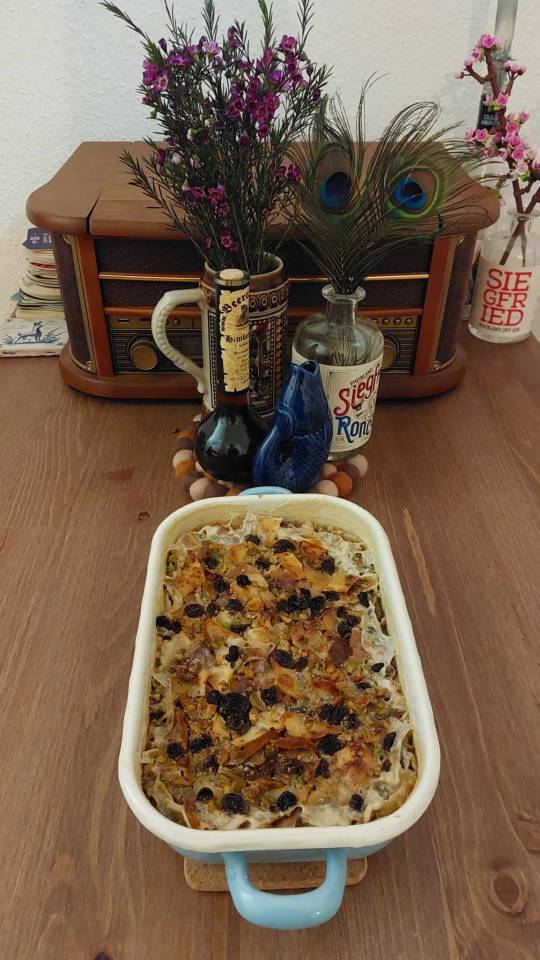

OM ALI & ROQAQ (10th c.)
Finally with some more free time on my hands, I decided to make this longer Tasting History recipe: Om Ali & Roqaq, Egypt's national dessert, this version made with Roqaq, a crisp Egyptian bread that is accurate to the time period. This Om Ali recipe comes from the 10th century Kitab al-Tabikh (Book of Dishes) by Ibn Sayyar al-Warraq, the earliest known Arabic cookbook, which was written in Baghdad and contains more than 600 recipes. In Max's modern version of the recipe, he has added a few other ingredients which were commonly added in medieval Egypt, like nuts, sultanas, and spices. Other ingredients like camphor and chicken were included in other medieval recipes for Om Ali, so it seems to have been a fairly flexible dish. The name of the dish itself, Om Ali, means "Mother of Ali". According to legend, this dish originated as a celebration of the 1257 death of Shajar al-Durr, a slave and concubine-turned-wife who had been married to Egypt's final Sultan from the Ayyubid dynasty, As-Salih. She ruled secretly before the rest of Egypt knew that he had died, and when they did find out, Shajar brought in the sultan's estranged son, Turan Sha, to rule. However, he was known to be a ruthless and controlling ruler who wanted to get rid of the previous ruling class, the Mamluks. So, the Mamluks sided with Shajar and they plotted to kill him; he was stabbed and thrown into the Nile. The Mamluks backed Shajar, and she thereby became Egypt's first and only female sultan. The Ayyubids were not happy about this appointment and began to revolt, and the Caliph of Baghdad was also not impressed. So, due to pressure from these groups, Shajar married the general who would later become the first of Egypt's Mamluk Sultans, Izz al-Din Aybak. They shared ruling powers for a time, but eventually Aybak took over more and more of the powers. After finding out Aybak had married the daughter of the Emir of Mosul, and probably at the end of her rope after losing her powers as sultan, Shajar al-Durr plotted the murder of Aybak. She had her servants kill him, but her role in his death was discovered. She was imprisoned and eventually put to death, and Aybak's first wife, Om Ali, returned. Om Ali's son, Al-Mansur Ali, became sultan. Om Ali asked to have a dessert prepared - some say in celebration of Shajar al-Durr's death and some say in celebration of Aybak's death - and this dessert became popularized throughout Egypt and named after Om Ali. It was said the original cooks used what ingredients they had on hand - bread, milk, and sugar - forming the base of the dessert. Now eaten with more ingredients, the dessert is still made today and is eaten particularly for iftar or sunset dinners during Ramadan. For more details about the origin story of this dish, see Max’s video on how to make this dish here or see the ingredients and process at the end of this post, sourced from his website.
My experience making it:
I halved the recipe, since I will just be baking for me and my husband. I omitted the almonds, since I'm not a huge fan of them. I love pistachios however, so I did use those, although I could only find shelled, roasted, and salted ones. For some reason, when I opened my bag of sultanas, which were labelled correctly and looked just like Max's in the picture on the label, just normal, dark-coloured raisins were inside. So, I just used normal raisins instead of sultanas. Other than these changes, I stuck to the ingredient list.
I began by making the Roqaq. I mixed the salt into the flour in a bowl, then added enough water until it turned into a dough. This was a really sticky process, stickier than other doughs I have made before! Eventually, however, with enough kneading, it did turn into a proper dough. I did have to add a little extra flour in order to prevent it from getting too sticky, though. I put the dough into a ball and wrapped it in cling wrap, leaving it to rest for an hour. In the meantime, I portioned out the rest of the ingredients I would need for this recipe and preheated the oven. After the dough had rested, I divided it into equal sections and rolled one small ball out at a time, putting one rolled-out Roqaq into the oven at a time also, since they were quite big and took up a whole baking pan. One at a time, I repeated this process with each dough ball. Unfortunately though, I had read the preheating instruction under the Om Ali section instead of the Roqaq section, and as a result, the oven wasn't hot enough and it took a whole 20 minutes to get each Roqaq to enlarge and crisp up. A bit of a drag! Still, the Roqaq came out nice and crisp, just like Max's.
Next, I began making the Om Ali with the Roqaq bread by crumbling it up into a small casserole baking dish. My oven was already preheated to the right temperature thanks to my earlier mistake. I melted the butter and poured it evenly over the crumbled Roqaq. I skipped the step to toast the nuts, since my pistachios were already pre-roasted. I just crushed them with my mortar and pestle and sprinkled them over the dish evenly, doing the same right after with the raisins. Then, I whisked the milk, cream, and sugar together in a pot and set it over the stove until simmering. I took it off the heat, let it cool just slightly, then added the rose water, cinnamon, and cardamom. It took a bit of mixing until it combined fully, but it eventually got there. I poured the milky mixture over the casserole dish, doing my best to cover all of the solid ingredients and pushing the bits of Roqaq down where necessary. I put it in the oven for 25 minutes, and indeed, the top was browning and the milk was bubbling up the sides when I took it out! I let it sit for a bit to cool, then served it up for dessert for my husband and I after our nice dinner of chicken and salad. By then, the milk 'bubbles' had popped and kind of looked like a sticky cheese substance - this did not look very appetizing - but the other elements - the browned Roqaq, raisins, and pistachios - looked quite yummy! I was happy, in the end, that it looked similar to Max's finished dish.
My experience tasting it:
I will first mention that during the process of making this dish, I did try the baked Roqaq bread on its own first, both half-way through baking - when it tasted like pita bread - and when it was finished baking - when it was like really thin Italian Grissini. In general, it was a very neutral taste that would probably be best used with some dips or spreads. The texture was quite nice though! Pretty impressive for only three ingredients.
After dinner, we tried the Om Ali, still warm from the oven. I was honestly expecting it to be soupy from all that milk and cream, but it seemed the Roqaq had soaked up the liquid quite well. It was a little difficult to cut and serve and looked like a bit of a hodge-podge on the plates, but you could easily see each of the main ingredients there. I tried to get a first bite with some crisp from the Roqaq on top, some Roqaq soaked in liquid from the bottom, and some pistachio crumbs and raisins. It was a delicious bite! My first thought, probably due to the cinnamon, was that it tasted like cinnamon toast crunch, undoubtedly due to the cinnamon and milk taste with some crumbles that had soaked it up. While Max says the texture of the Roqaq in this dish is kind of like noodles, I disagree. Mine did not have quite that floppy of a texture. Perhaps it was a little stodgy in places, as the layers of Roqaq had kind of compressed together, but it reminded me more of stacked and layered crepes with a lovely cinnamon sauce. The pistachios added a nice texture, but I couldn't taste them too strongly - perhaps I should have added more. The raisins were a nice burst of flavour, however. I was very suprised I couldn't taste the cardamom or rose water very much, since those are both known to be fairly strong in flavour and can easily take over a dish. Perhaps they play more of a nuanced role in the overall taste of the dessert. I tried the dessert again the next day, this time cold from the fridge: I think I prefer it this way! I have heard that flavours can grow stronger in the fridge overnight, and this was definitely the case - even more cinnamon flavour, which I really like. As tasty as Om Ali was, I don't think I will be making this specific recipe again. Overall, it took me over 3 hours to make (although partially due to my oven pre-heating mishap). However, if I find a more modern Om Ali recipe online that takes less time to make, I will probably make it again, since it was tasty. I can see why Egyptians are very proud of this dessert dish and why it has lasted centuries. If you end up making this dish, if you liked it, or if you changed anything from the original recipe, do let me know!
Om Ali original recipe (1904)
Sourced from the Kitab al-Tabikh by Ibn Sayyar al-Warraq (10th c.).
Take semolina or white bread and soak it in milk until saturated. Then, take half a pound of sugar, or as much as is needed for the amount of bread, crush it, and mix it with the bread. Then, take a clean and shallow pot…add the soaked bread, milk, and sugar…Return the pot to slow burning coals. When the filling is cooked and set, remove the pot from the fire, turn it out onto a wide bowl and serve, God willing.
Modern Recipe
Based on the recipe from Kitab al-Tabikh by Ibn Sayyar al-Warraq (10th c.) and Max Miller’s version in his Tasting History video.
Ingredients:
Roqaq
1/2 tsp salt
3 3/4 cups (450 g) flour
Generous 3/4 cup (200 ml) water
Om Ali
1/2 cup (113 g) melted butter
3/4 cup (85 g) slivered almonds
3/4 cup (90 g) shelled pistachios
1 cup (150 g) sultanas
1 quart (1 L) whole milk
2 cups (1/2 L) cream
3/4 cup (150 g) sugar
3/4 tsp cinnamon
3/4 tsp cardamom
1 tsp rose water
Method:
For the Roqaq: Mix the salt into the flour, then add the water and mix until it forms a dough.
Turn the dough out onto a counter or work surface and knead for about 15 minutes or until smooth.
Once smooth, wrap the dough in plastic wrap and let it rest for 1 hour.
Preheat the oven to 475°F (245°C).
After the dough has rested for 1 hour, divide it into 8 equal pieces and form them into balls. Roll and stretch each dough ball as thin as you can make it. Place the rolled out dough onto a baking sheet (you may only be able to fit 1 or 2 at a time) and bake for 5 minutes or until the bread has puffed up, gotten some color, and is crispy. You can bake the bread for about 2 minutes if you want to use it for something like a wrap, but for this recipe, we want the bread crisp.
For the Om Ali: Preheat the oven to 400°F (205°C).
Crumble the roqaq into a large baking dish. Pour the melted butter over the roqaq pieces.
Toast the almonds and pistachios in a dry pan over medium heat, stirring frequently, until they’re nice and fragrant. Crush the toasted nuts lightly, then sprinkle them evenly over the crumbled roqaq, followed by an even layer of the sultanas.
Whisk together the milk, cream, and sugar in a pot, then set it on the stove and bring it to a simmer. Remove it from the heat and let it cool for 5 minutes, then whisk in the cinnamon, cardamom, and rose water.
Gently pour the milk mixture over the roqaq mixture. Lightly push down the roqaq, nuts, and sultanas to make sure that all of the roqaq gets soaked.
Bake for 25 minutes or until the top is browned and the milk bubbles.
Take the Om Ali out of the oven and serve it forth, warm or cold.
#max miller#tasting history#tasting history with max miller#cooking#historical cooking#keepers#10th century#medieval meals#egypt#baghdad#afghanistan#om ali#roqaq#bread#desserts#cinnamon#nuts#bread pudding#kitab al-tabik#ibn sayyar al warraq#shajar al-durr#arabic recipes#africa#royal meals#sultan#vegetarian recipes
2 notes
·
View notes
Text
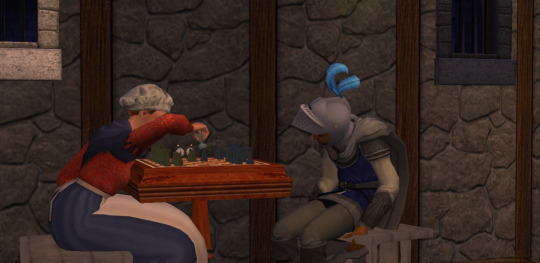
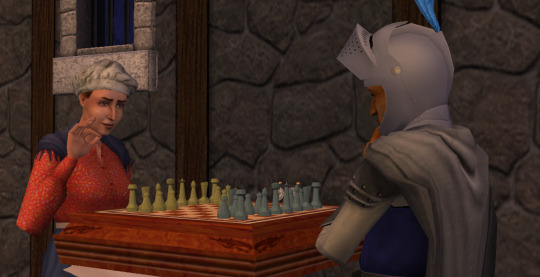
-- A game of chess, Arista? I didn't know you played. --The creatures are put to bed. They're growing mighty fast.
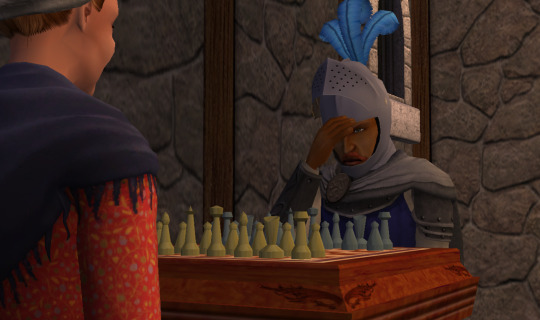
-- Good. Soon enough I can train them. Once they're of age, I can present them to the queen as new knights of the realm.
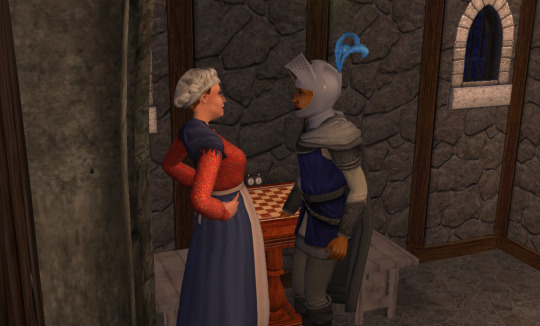
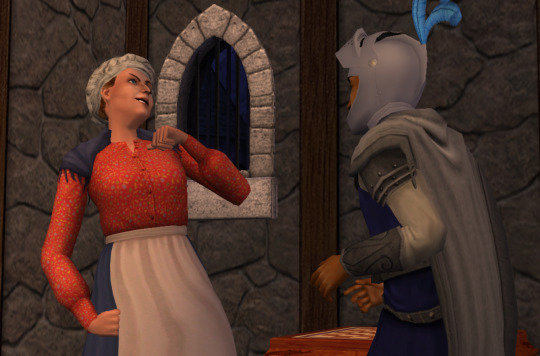
--Arista, I appreciate you looking after them. It's no small task. --Aye. But I've got the experience. --If you don't mind me asking...you've raised children before? Your own? -- You think I've got children? Where dya suppose I'd be hidin' them? No. My work as a scullery maid in days past. Weaned many a babe in my day.
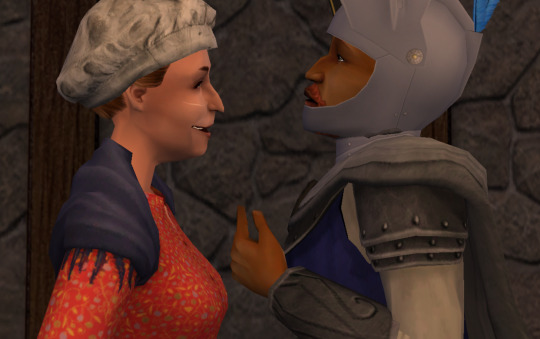
-- Your confidence is staggering. You remind me of a woman I once knew.
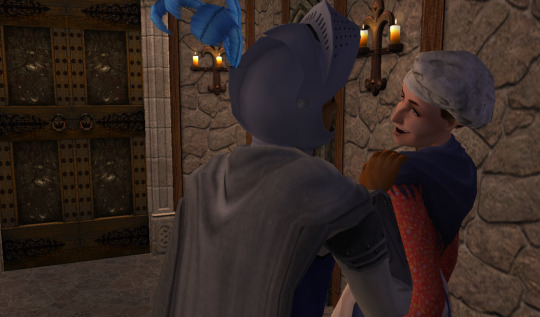
-- Can't be. I'm one of a kind, sherriff.
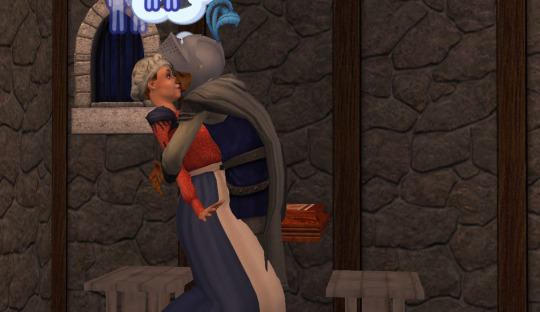
#BLEGH a la most important meal of the day serving it up gary's way#ts2#the sims 2#the sims#sims stories#ts2 gameplay#sims 2#sims 2 medieval#sims warwickshire challenge
13 notes
·
View notes
Text
bread tastes best when ripped and dipped, not cut and slathered
#saw a post about medieval meals. this is why it’s so good#it’s the tactile goodness of a good rip#get that whipped butter and dip bread in that it feels like banquet table behavior#bread#BREADDD#i love bread
6 notes
·
View notes